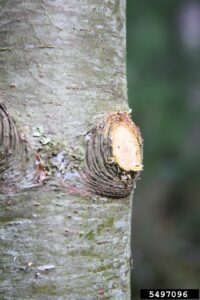To Prune or Not to Prune: A Gardener’s Fall Dilemma
go.ncsu.edu/readext?1039131
en Español / em Português
El inglés es el idioma de control de esta página. En la medida en que haya algún conflicto entre la traducción al inglés y la traducción, el inglés prevalece.
Al hacer clic en el enlace de traducción se activa un servicio de traducción gratuito para convertir la página al español. Al igual que con cualquier traducción por Internet, la conversión no es sensible al contexto y puede que no traduzca el texto en su significado original. NC State Extension no garantiza la exactitud del texto traducido. Por favor, tenga en cuenta que algunas aplicaciones y/o servicios pueden no funcionar como se espera cuando se traducen.
Português
Inglês é o idioma de controle desta página. Na medida que haja algum conflito entre o texto original em Inglês e a tradução, o Inglês prevalece.
Ao clicar no link de tradução, um serviço gratuito de tradução será ativado para converter a página para o Português. Como em qualquer tradução pela internet, a conversão não é sensivel ao contexto e pode não ocorrer a tradução para o significado orginal. O serviço de Extensão da Carolina do Norte (NC State Extension) não garante a exatidão do texto traduzido. Por favor, observe que algumas funções ou serviços podem não funcionar como esperado após a tradução.
English
English is the controlling language of this page. To the extent there is any conflict between the English text and the translation, English controls.
Clicking on the translation link activates a free translation service to convert the page to Spanish. As with any Internet translation, the conversion is not context-sensitive and may not translate the text to its original meaning. NC State Extension does not guarantee the accuracy of the translated text. Please note that some applications and/or services may not function as expected when translated.
Collapse ▲As autumn fades and winter approaches, gardeners often wonder: Is now the right time to prune? Timing matters, and knowing when and how to prune can make the difference between a thriving plant and one that struggles.
Why Prune in Dormancy?
Late fall to early winter, when plants enter dormancy, is ideal for selective pruning of many deciduous trees and maintenance pruning of shrubs. This time of year offers distinct benefits:
- Reduced Plant Stress: Dormant plants can better handle cuts without unnecessary stress.
- Clear Visibility: Without leaves, it’s easier to see and shape the plant’s structure.
- Lower Disease Risk: Cooler temperatures reduce pathogen activity, minimizing the risk of infection at cut sites.
Prune with Purpose: Avoid Topping!
While pruning is essential for many shrubs, you should never heavily prune a tree. The topping technique—cutting large branches or the main trunk to stubs—should be avoided. Be wary of tree services that offer topping as a pruning technique.
Topping leads to:
- Weak Regrowth: New shoots are weaker and prone to breakage.
- Disease Vulnerability: Large wounds from topping can struggle to heal, making trees susceptible to decay and pests.
- Loss of Natural Form: Topping damages the tree’s natural shape, resulting in an unsightly appearance.
Instead, focus on selective pruning. This means pruning out dead, diseased, or dying branches, which provides substantial benefits:
- Enhanced Health: Removing compromised branches prevents the spread of disease and improves air circulation and sunlight penetration.
- Increased Safety: Reducing dead limbs decreases the risk of falling branches during winter storms.
- Sustained Growth: Careful pruning maintains the tree’s natural form and encourages healthy growth.
How to Prune Safely:
- Identify problem branches showing signs of decay, disease, or damage. If the branches look diseased, be sure to sanitize in between cuts so you do not spread the disease to other parts of your shrub or tree.
- Make clean cuts back to the main trunk or a healthy lateral branch, maintaining the branch collar to support healing.
- Use sharp, clean tools like pruning saws or loppers for precise, smooth cuts.

An example of a correct pruning cut: The branch collar remains intact, and the cut was made back to the trunk or a healthy lateral branch, promoting proper healing and growth.
Techniques for Effective Pruning
To ensure effective pruning, follow these guidelines:
- Types of Cuts: For shrubs, use thinning cuts for better light penetration and heading cuts to promote growth.
- Angle and Placement: Make cuts at a slight angle above an outward-facing bud.
- Tools Needed: Hand pruners for small branches (up to ½” thick), loppers for thicker ones ( ½” – 1½” thick), and pruning saws for larger limbs.
To Prune or Wait?
- Prune Now: Dormant deciduous trees and shrubs.
- Wait Until Spring: Spring-flowering shrubs (e.g., azaleas, forsythias, roses) and evergreens.
- Avoid Pruning: Plants that may still be growing or at risk of frost damage.
Common Mistakes to Avoid
- Wrong Timing: Pruning spring-flowering plants in fall reduces blooms.
- Flush Cuts: Cutting too close to the trunk removes the branch collar and hinders healing.
- Over-Pruning (Topping): Cutting more than 25% of a tree’s canopy stresses the plant, can cause disease, and overall weakens the tree.
For healthy plants and a vibrant spring, make the right cuts at the right time. Thoughtful pruning and avoiding harmful practices can make all the difference. For detailed diagrams, in-depth how-tos, and a link to our monthly pruning calendar, check out the links below.




